Where to dig in?
Transform your backyard without emptying your wallet by focusing on DIY projects like gravel patios, simple paver pathways, and homemade raised beds. Choose low-maintenance, drought-tolerant plants that provide year-round interest while requiring minimal care. Create functional spaces with a simple fire pit using concrete blocks or local stones, and add solar lighting for evening ambiance. Repurpose everyday items like old buckets or pallets for unique planters and outdoor furniture. The following strategies on basic backyard landscaping ideas will help you create a beautiful outdoor space step by step.
Planning Your Budget-Friendly Backyard Makeover
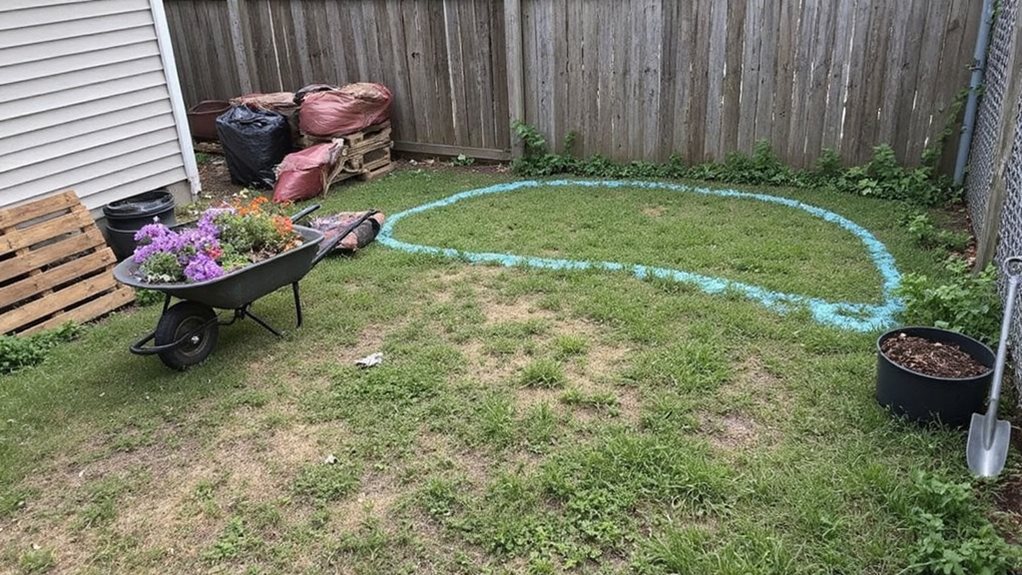
When you’re dreaming of transforming your backyard without breaking the bank, careful planning becomes your most valuable tool. Start by creating a prioritized wishlist that separates your “must-haves” from your “nice-to-haves,” allowing you to allocate funds efficiently where they matter most.
Set a realistic budget between $15,000-$30,000 for standard projects, and always reserve 10-15% for unexpected expenses. For specialized features like fire pits or small waterfalls, budget within the $15K-$20K range for best results. Consider breaking your project into manageable phases-focus on foundational elements like grading and pathways first, then add decorative features later.
Take advantage of free online planning tools to visualize your space before spending a dollar. For truly low-maintenance options, consider replacing high-upkeep lawns with gravel pathways bordered with potted plants. Remember to factor in often-forgotten costs like delivery fees, permits, and soil amendments. Finally, balance professional services for complex work with DIY opportunities for simpler tasks like planting and mulching.
DIY Landscaping Projects That Won’t Break the Bank
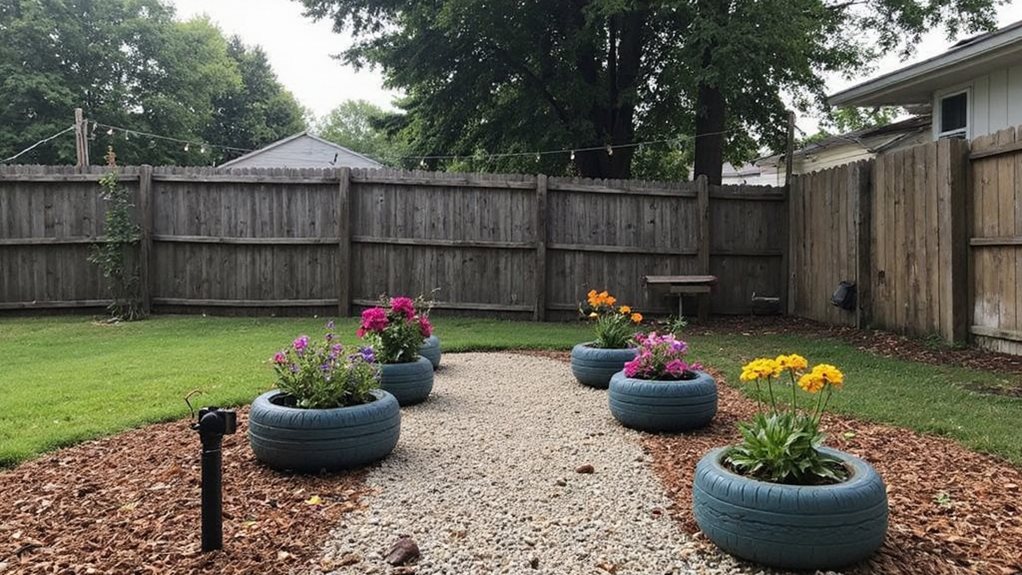
Now that you’ve planned your budget-friendly backyard makeover, it’s time to roll up your sleeves and get to work. Several projects offer maximum impact with minimal investment.
Transforming your outdoor space doesn’t require a hefty budget-just creativity, elbow grease, and smart planning.
Budget-Friendly Hardscaping:
- Build a floating deck using pressure-treated wood for a fraction of professional costs
- Create easy gravel patios by laying landscaping fabric first, then adding inexpensive stone
- Install simple paver pathways in geometric patterns without special tools
Low-Cost Garden Features:
- Construct raised beds from cedar fence planks for under $50 each
- Repurpose pallets for planting beds, vertical gardens, or compost bins
- Add solar pathway lights for ambiance without wiring costs
- For container gardens, use specialized soil mixes that incorporate perlite and compost to prevent compaction and provide optimal drainage for healthy plants.
Quick Aesthetic Upgrades:
- Refresh with fresh mulch in planting areas
- Paint existing furniture with weather-resistant paint
- Create container gardens from upcycled materials
- Consider installing X-board weed barrier under mulched areas to reduce maintenance and extend the life of your landscaping.
Low-Maintenance Plants for Beautiful Results
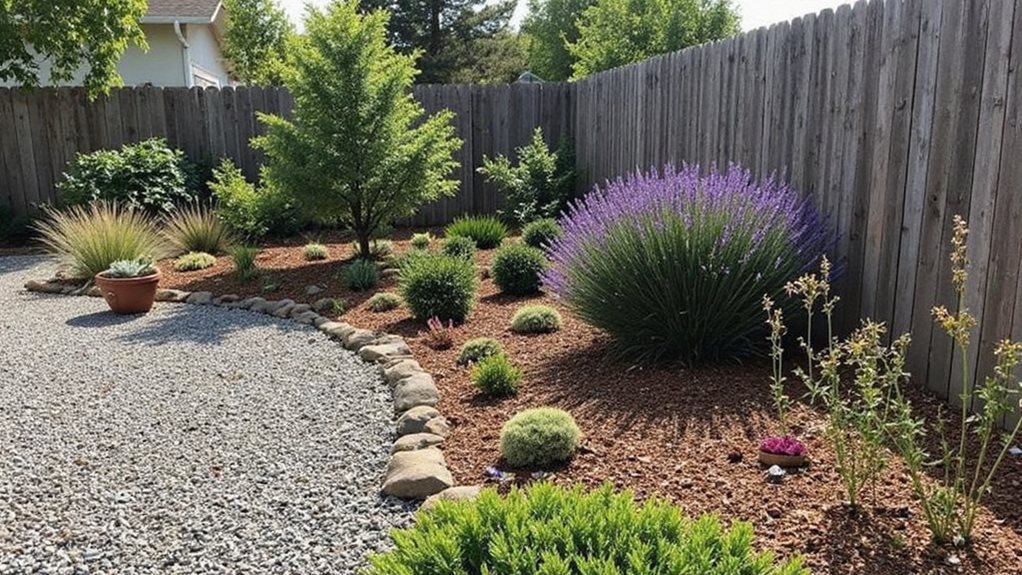
Many stunning plants require minimal effort while delivering maximum beauty for your budget landscape. Choose drought-tolerant perennials like hostas for shady areas or sedums for sunny spots, as they’ll thrive with minimal watering once established.
For year-round structure, compact shrubs such as boxwood and dwarf hydrangeas provide visual interest without constant pruning. Native plants offer exceptional value, supporting local wildlife while naturally resisting regional pests and diseases. Potentilla shrubs are excellent choices for budget landscapes, offering spring-to-fall interest with their bright flowers and minimal care requirements. Consider incorporating a mix of annual and perennial plants to create continuous visual appeal throughout the seasons.
Consider these low-maintenance options:
- Groundcovers like creeping thyme or ajuga to suppress weeds
- Daylilies for repeated blooming with almost no care
- Liriope as a grass-like border that rarely needs attention
- Small trees such as crape myrtle or serviceberry for seasonal interest
These plants will reduce your maintenance time and water bills while creating a beautiful landscape.
Creating Functional Outdoor Spaces for Less

Creating a functional outdoor space doesn’t require expensive materials or professional installation. You can transform your backyard into a practical retreat by using budget-friendly alternatives that still deliver style and function. Focus on defining areas for specific activities while incorporating affordable materials that withstand weather and use. Consider implementing multi-level deck designs to maximize space and create visual interest in smaller yards. Invest in a quality expandable hose for efficient watering that’s lightweight and prevents frustrating kinks during your gardening tasks.
- Build a simple fire pit using repurposed materials like concrete blocks or locally sourced stones, creating a cozy gathering spot for evening enjoyment
- Install gravel pathways to connect different areas of your yard, providing good drainage and requiring minimal upkeep
- Create a DIY patio using locally sourced pavers or reclaimed materials, saving on both materials and installation costs
- Add solar lighting along walkways and gathering areas for safety and ambiance without increasing your electric bill
Upcycling and Repurposing in Your Landscape Design
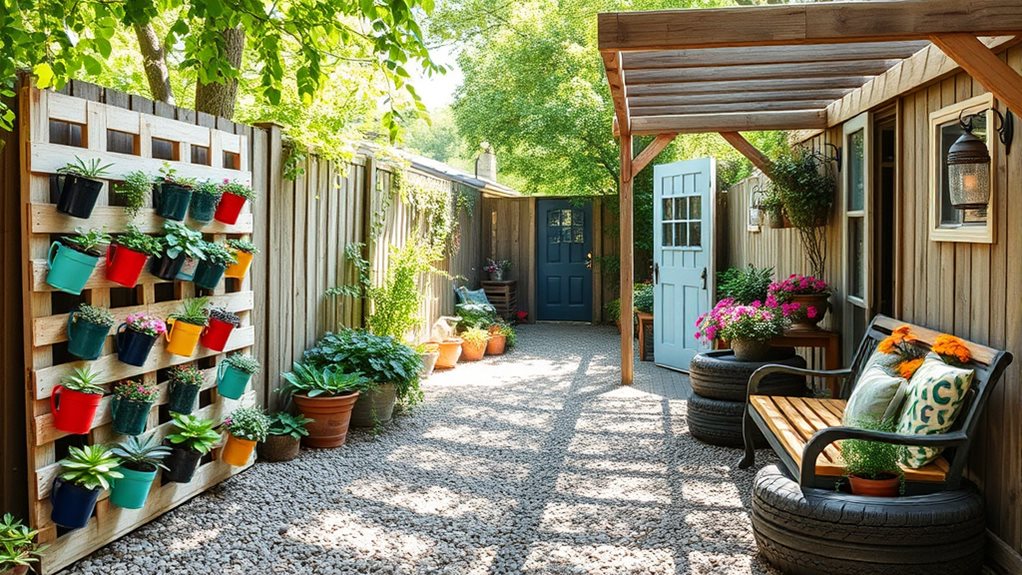
While professional landscaping features often come with hefty price tags, upcycling everyday items can transform your backyard without emptying your wallet. Look around your home for containers that can enjoy a second life as planters-old buckets, wine bottles, jars, and even unused wheelbarrows make charming homes for flowers and herbs.
Create sustainable garden decor by fashioning art pieces from recycled materials like glass, fabric, or wood. Old doors can be repurposed in over 100 ways to create unique garden features. Those pallets gathering dust in your garage? Turn them into practical outdoor seating or tables. For plant identification, paint stones or repurpose tiles as attractive, weatherproof labels. When working with these materials, invest in quality implements like the dual-edged blade tools that can handle both planting and weeding tasks efficiently.
Even larger structures can be reimagined on a budget. Convert unused sheds into garden bars, or build mini greenhouses from old windows and doors. Your backyard’s next conversation piece might already be sitting in your storage space!
Water-Saving Landscaping Techniques
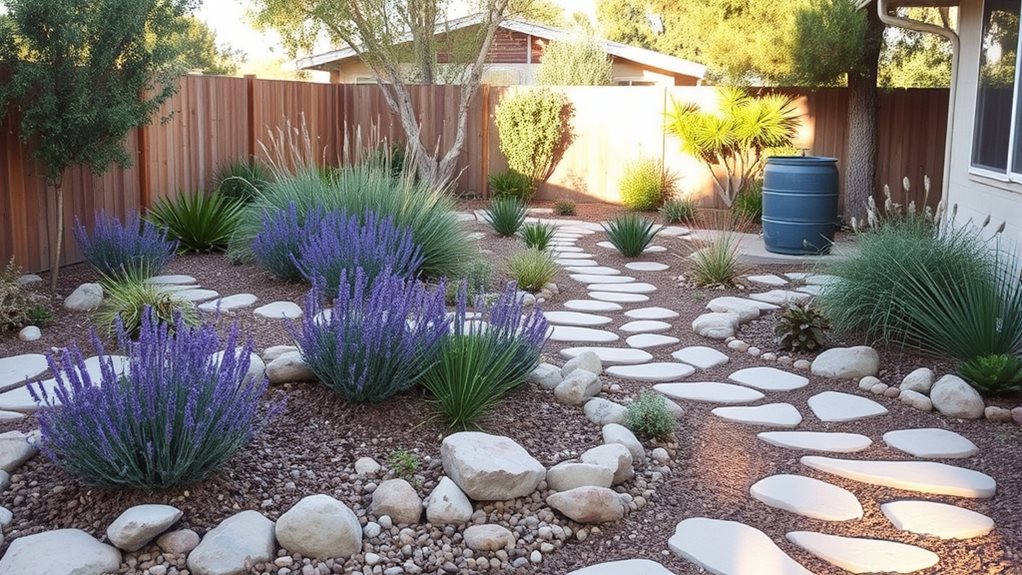
As water resources become increasingly precious, smart homeowners are turning to water-efficient landscaping to create beautiful yards without excessive irrigation. You’ll save money on water bills while still enjoying a lush, attractive outdoor space by implementing a few simple strategies.
- Choose drought-tolerant native plants that thrive in your local climate, reducing the need for supplemental watering and maintenance
- Install a drip irrigation system or soaker hoses that deliver water directly to plant roots, cutting waste by up to 70%
- Apply a 2-3 inch layer of mulch around plants to retain moisture, suppress weeds, and regulate soil temperature
- Group plants with similar water needs together in “hydrozones,” ensuring each area receives just the right amount of water
Consider implementing no-till gardening practices in your planting beds to improve soil structure and increase water retention capacity naturally.
Consider installing permeable paving in walkways and driveways that allows rainwater to seep into the ground rather than running off and overwhelming drainage systems.
Simple Lighting Ideas to Transform Your Backyard
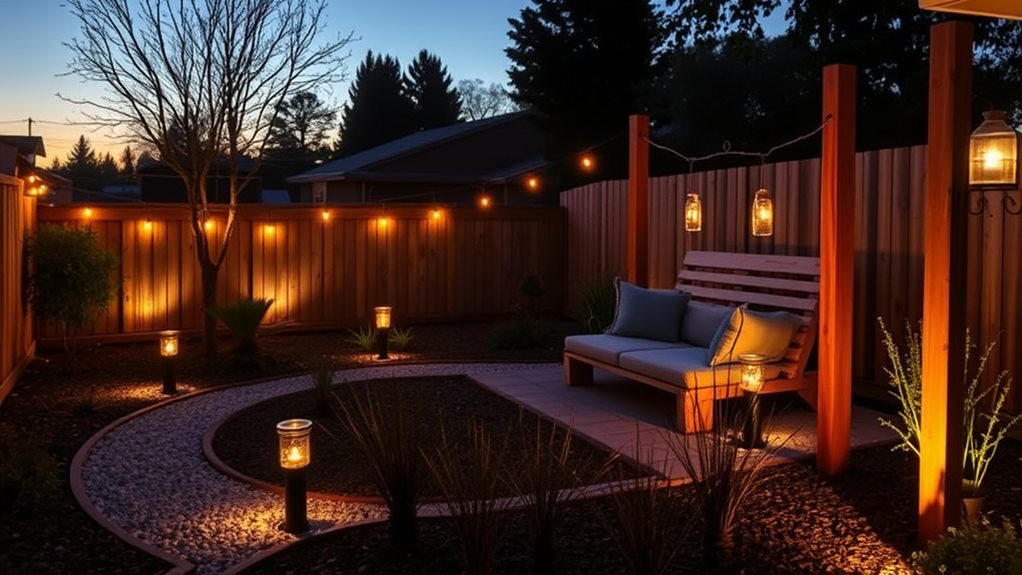
The right outdoor lighting can dramatically enhance your backyard’s appeal without breaking your budget. String lights draped across fences or trees create a cozy ambiance for just $12-$40, while solar path lights illuminate walkways without complex wiring. Mason jar lights offer a rustic charm to any outdoor space while being a budget-friendly DIY option.
| Lighting Option | Price Range | Key Benefits |
|---|---|---|
| String Lights | $12-$40 | Versatile, easy installation |
| Solar Path Lights | $12-$40 | No wiring, automatic operation |
| Lanterns | Under $40 | Portable, aesthetic appeal |
| Floodlights | $15-$30 | Wide coverage, security |
| Step/Deck Lights | $9-$40 | Targeted illumination, subtle |
For security and larger areas, consider affordable floodlights with motion sensors. If you have a small lawn and want to focus your budget on lighting rather than expensive equipment, a budget mower like the Webb 30cm Autoset can help you maintain your grass without overspending. Battery-operated lanterns offer flexibility for tables and garden beds. Low-profile deck lights highlight pathways while blending seamlessly with your landscape, providing function and beauty without professional installation.
Frequently Asked Questions

How Long Does a Budget Landscaping Project Typically Take?
Your budget landscaping project will typically take 3-4 weeks from start to finish. This includes:
- Design phase (1-2 weeks)
- Material ordering (3-7 days)
- Installation (3-14 days)
Simple front yard projects may finish in just a few days, while backyard projects often take longer. You’ll save time by planning ahead, making firm decisions about materials, and scheduling work during off-peak seasons when contractors are more available.
Can I Landscape Effectively in Shaded or Problematic Soil Areas?
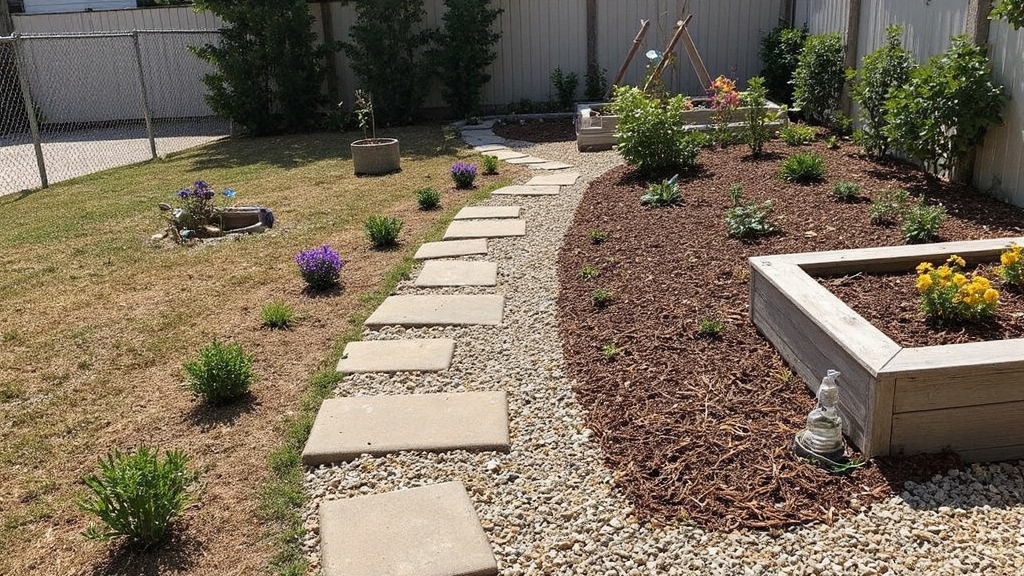
Yes, you can definitely landscape effectively in shaded or problematic soil areas. For shaded spaces, choose plants with variegated or light-colored foliage, install strategic lighting, and consider white-flowering perennials that brighten dark corners.
For poor soil, start with a soil test, add organic amendments, and select plants naturally adapted to your conditions. Remember, hardscaping elements like gravel paths or decorative stones can replace struggling plants in extremely challenging spots, creating visual interest without the struggle.
Which Landscaping Investments Offer the Best Return on Resale Value?
You’ll get the highest return from basic yard care, which yields an impressive 539% ROI for about $4,500. Standard lawn care services (217% ROI) and landscape maintenance like mulching and pruning (104% ROI) are also excellent investments.
Don’t overlook mature trees, which can boost property value by 7-15%. For maximum impact, focus on low-maintenance native plants and affordable upgrades like mulching and pathway edging that appeal to practical buyers.
What Permits Might I Need for Backyard Landscaping Projects?
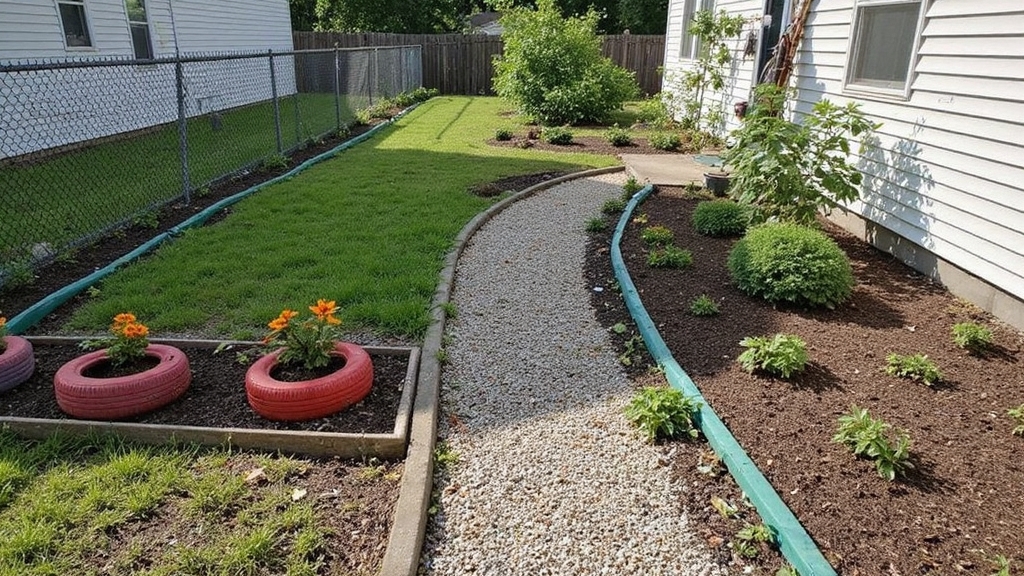
For your backyard project, you’ll likely need several permits depending on what you’re planning:
- Basic landscaping changes typically don’t require permits if you’re just adding plants or small features
- Structural elements like gazebos, pergolas, or outdoor kitchens need building permits
- Irrigation systems may require permits, especially if modifying water lines
- Tree removal might need specific permission, particularly for protected species
- Water features often require permits for electrical and plumbing work
Check with your local planning department before starting any project.
How Do Seasonal Changes Affect Budget Landscaping Choices?
Seasonal changes directly impact your budget landscaping choices in several ways. You’ll need to:
- Plan for different maintenance costs each season (lower in winter, higher in spring/summer)
- Choose plants that thrive in your local climate to reduce replacement expenses
- Schedule major projects during off-peak seasons when contractor rates may be lower
- Invest in weather-resistant materials that won’t need frequent replacement
- Purchase supplies during end-of-season sales to maximize savings
Conclusion
You’ve now discovered that creating a beautiful backyard doesn’t require a fortune. By planning carefully, choosing DIY projects, and selecting low-maintenance plants, you’ll transform your outdoor space affordably. Remember, upcycling old items gives your landscape character while saving money. Water-saving techniques will reduce your utility bills, and simple lighting creates magic after sunset. Start with one small project this weekend, and watch as your budget-friendly backyard paradise takes shape step by step.

